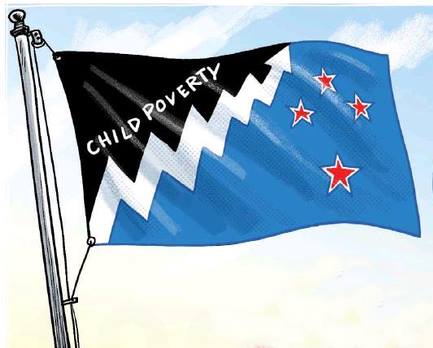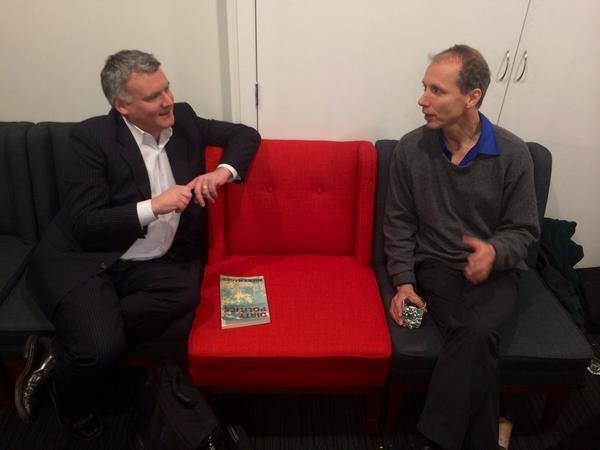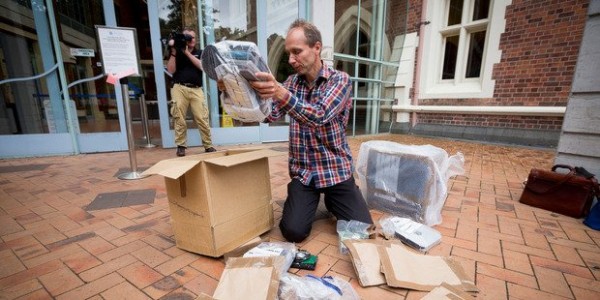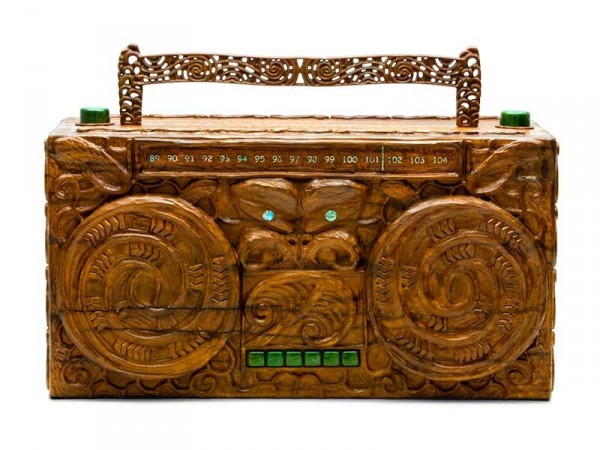Announce protest actions, general chit chat or give your opinion on issues we haven’t covered for the day.
Moderation rules are more lenient for this section, but try and play nicely.
Joining us tonight to discuss the impact of climate change in the Pacific…
In the studio – International Refugee Lawyer who has worked internationally with NGOs and the UNHCR – Michael Timmins
Director of the Pacific Media Centre – Dr David Robie
On the phone from Samoa – Ötara-Papatoetoe Local Board Councillor – Efeso Collins
And on Skype live from Kiribati as part of his fact finding mission in the Pacific – Labour Party Spokesperson on Pacific Affairs and Pacific Climate Change Sua William Sio

As any advertising agency would tell you, the purpose of a brand is to sell an experience and create an illusion.
John Key’s devotion to the All Black’s brand is not without good reason.
The silver fern is a dream brand. It evokes images of strength, success and superiority. It allows us to experience the joy of winning and makes us happy and hopeful about the future.
The inclusion of the silver fern in the design of the new flag was about creating an illusionary identity that said a lot about the victory and success of our rugby team but nothing about our nation’s cultural hallmark of simplicity and humility- the very virtues that the world desperately needs in order to face the global challenges of growing inequality and climate change.
For many New Zealanders, waving a flag embellished with a victorious corporate brand at the time of rising inequality and shocking levels of child poverty seemed at best inappropriate and at worst deceitful.
Many also struggle with New Zealand’s “clean and green” brand given the state of our waterways and lack of any real commitment to environmentally sound policies.
The attempt to change our flag at the same time as the introduction of the TPPA comes as no surprise to those who understand the role of the TPPA in strengthening corporate power.
A corporatized economy requires its consumers to strive for a dream and live within an illusion. This, for instance, explains the rapid rise of celebrity culture where consumers are encouraged to disengage with reality and immerse themselves in a fantasy life where ordinary people emulate the looks and behavior of the celebrities.
The new flag was designed to feed us, and the rest of the world, an illusion that we were a successful nation on top of the world where our rugby had taken us. That illusionary success was to be John Key’s enduring legacy.
In 2008, the brand Obama won the Advertising Age’s marketer of the year beating established brands such as Apple and Nike. It was the first time that branding and design had played a pivotal role in an American election.
The awe-inspiring brand Obama was about grass-roots democracy and progressive values, but like many brands, the promise did not match the reality.
Brand Obama has effectively handed over 12.8 trillion dollars of taxpayers’ money to Wall Street and insolvent bankers, expanded America’s doomed imperial project in Afghanistan, has refused to restore habeas corpus and has failed to introduce single-payer universal health care that Americans so desperately need.
Much of John Key’s political success can also be attributed to his strong personal brand: likeable, entertaining, and one of us. The reality, however, points to a man unlike many; a master illusionist without any real convictions who is determined to win at all costs (think dirty politics).
I am proud that despite many manipulative advertising attempts, New Zealanders were not duped into mistaking an illusion offered by a brand with the reality representing our true identity.
In time, when our nation finds the courage to face its demons (child poverty, domestic violence, unemployment, poor and expensive housing, growing inequality, youth suicide, etc.) and find its way towards unity and common good, we will have a new flag that we can all be proud of.

The union representing Bunnings workers is welcoming the company’s decision to install defibrillators in five stores, including in stores where staff-owned defibrillators were removed.
“Workers in Dunedin, Nelson and Gisborne were heartbroken when the company removed their staff-owned defibrillators,” said FIRST Union Retail and Finance Secretary Maxine Gay.
“Having a defibrillator on hand can mean the difference between life and death. Bunnings decision to remove defibrillators they didn’t own and didn’t pay to maintain never made any sense.”
“But thanks to the public’s vocal support, Bunnings management has backed down and agreed to install defibrillators in five stores.”
“Bunnings workers are so grateful for the tremendous public support they’ve received and they hope this decision signals a more conciliatory and even-handed approach to workers’ issues,” says Gay.


The long running dispute between Auckland bus drivers and their employer is heading to the courts as FIRST Union, the union representing drivers at Howick and Eastern Buses, files two cases in the Employment Relations Authority against the East Auckland bus company for “serious and sustained” breaches of the Employment Relations Act.
The union is seeking costs and $2 million in penalties.
“The law is crystal clear – you must negotiate in good faith and you must not undermine collective bargaining. But Howick and Eastern Buses has repeatedly breached that obligation,” says FIRST Union organiser Rudd Hughes.
The union is alleging the company breached its obligation to bargain in good faith after offering individual union members cash enticements in exchange for signing an individual employment agreement that removed their right to extra pay for working on non-rostered days and Sundays.
Under section 32(1)(d)(ii) of the Employment Relations Act an employer cannot negotiate directly or indirectly with individual union members while collective bargaining is taking place.
“The company’s actions amount to a very serious breach of employment law. We’ve tried to reason with them, our members have even gone on strike, but each time the company has doubled down.”
After enticing a number of union members to sign individual employment agreements the company also unilaterally changed rosters to lift hours for drivers on the new individual contracts and reduce hours for drivers on the collective contract.
“This sort of discrimination will not be tolerated. Auckland Transport pays Howick and Eastern Buses to run bus services, not union-busting campaigns.”
“It should worry every Aucklander that ratepayers’ money is being wasted in this way.”
The union is seeking costs plus a $20,000 penalty per union member who the company attempted to bargain with directly.


As I may have remarked several times before on this blog, one of my favourite MPs from NZ First’s 2014 intake is Darroch Ball. There’s good reason for this. The relevant Minister (Anne Tolley) is afraid of him; he’s not afraid to call a ground-breaking instrument a spade when it comes to issues in his portfolio; but most important of all, he’s an ‘ideas man’ – and puts his demonstrable intelligence to work coming up with actual, practicable legislative solutions to our issues as a Nation.
The latest piece of evidence for this is contained in Darroch’s most recent Private Member’s Bill, the ‘Youth Employment, Training and Education’ bill.
This is a revolutionary concept which proposes to help some of the 71,000 young people presently not engaged in any form of education, employment or training (or NEETs, for short), by providing an alternative pathway into these fields for youths aged 15-17 through the New Zealand Defence Force and Ministry of Social Development.
What the scheme will do is allow kids in that age-range to transfer straight from school into an Army/MSD-run program that will teach the youths in question a trade and some skills, instill discipline through living in a controlled environment, provide a ready and skilled labour force for community improvement by local governments, and also pay the kids a training wage – the majority of which will be paid out upon their ‘graduation’ from the program (potentially allowing them to fund an OE, a car and the bond for a flat, or even perhaps contribute to the down-payment on a mortgage for a house). At the end of the scheme, they’ll be helped into employment (if they wish) thanks to the Government providing a twelve month subsidy incentive to employers to hire them.
In short, it’s about providing an alternative to the upper years of high school for many of the young people who’re demonstrably not being engaged by the education system at present, without letting their potential go to waste. And, in so doing, set them up for a productive, prosperous future rather than leaving them to languish as we evidently do now.
The scheme is not entirely novel in its execution, either. The NZDF-run Limited Service Volunteer program which Darroch’s bill is partially inspired by has an enviable success rate itself – more than 85% of enlistees graduate the program, of which 60% then find work or other engagement. There’s also interesting information showing that LSV graduates then stay off the benefit more than any other comparable group for some years after completing the program. Those are the positive numbers deliverable after a mere six weeks of work with at-risk youth. Now imagine how much of an impressive change a full three-year program with a comprehensive suite of trades and employable-skills training will make for a kid.
This will literally turn lives around for thousands, and get them off to a great start with adulthood.
And while those of us without children might view the prospective merits of this proposed solution as being somewhat academic, consider this:
A 2013 study by AUT economists pegged the costs to both the public purse and the wider economy of young people not presently engaged in education, training or employment – i.e. the group this scheme is designed to help – at around $27,000 a year per head. [1] There’s 71,000 of them.
That represents combined total costs to all of us of around 2.4 billion dollars: $1.39 billion in terms of lost productivity and wages, and more than a billion dollars of taxpayer money in the form of benefit money and forgone tax revenue. [2]
We can do something to stem this tide. We can recover some of this lost potential human promise.
We can support Darroch’s bill.
During my previous career as an educator working in low-decile schools, I lost count of the number of young people I encountered who would have benefited hugely from a scheme like this. There’s so many high school students out there who find that the academic environment of high school – with its often seemingly teleological if not outright myopic focus upon preparing kids for university entrance – ill-fitting for them.
As it stands at the moment at high school, these kids find themselves drifting through if not dropping out thanks to disengagement – and going on from there to lives of unemployment, crime or idleness. It’s sad, but the conventional strictures of the Education Act (specifically, s20 thereof) do not, at present, allow us to do terribly much to help them. By the time they hit their late teens (the minimum age at which they can opt out of school), it is in many cases too late for an easy – and life-changing – intervention. Former students face the choice between looking for qualificationless entry-level jobs that often simply aren’t there, or embracing long term unemployment and all that goes with it.
When it passes, Darroch’s bill will create an alternative pathway – using the transformative power of the state to establish an alternative for these young people, which will be available for them before that time-critical point of arguable no return in their late teens. The fact that they’ll effectively be employed (and paid) while also being trained, educated, and providing a solid service to their local community is key.
In a month that’s seen much discussion about the legacy-projects of vainglorious politicians, I’m genuinely excited that this bill presents tangible evidence that there’s at least one MP out there actually thinking about how he can make an enduring difference on into the future for our people and nation.
There are some caveats, of course. Recruits for the Youth Employment, Training and Education scheme are not soldiers – nor will they be treated as such. While subject to military discipline, they shall obviously not be used in a combat capacity, deployed overseas, given weapons training, or allowed to handle live ammunition. In addition to their trades or vocational training, recruits will also be required to attain a minimum of NCEA Level 2 Literacy and Numeracy qualifications – thus setting them up for prospective entry into further education should they so wish.
So all in all, even though – or perhaps especially because – this bill carries a heavy weight of detail and economic analysis in its reasoning … I am a thorough convert. It is no exaggeration to state that I find this to be one of the best Private Members’ Bills yet produced by any MP in this Parliament.
I do not state that because I know Darroch personally, nor because I am some form of NZ First uber-hack. Instead, I say it as someone who spent the best part of a decade proximate to the individuals this bill is designed to help, and who has grown up in and around the educational environment.
With that in mind, I look forward to watching this blessed “YETE” lope off into the sunset of a better tomorrow for literally tens of thousands of our young people.
[1] Pacheco, G. & Dye, J.. (2013). Estimating The Cost Of Youth Disengagement In New Zealand (Department of Economics Working Paper Series). Auckland: AUT University.
[2] Pacheco, G. & Dye, J.. (2013). Estimating The Cost Of Youth Disengagement In Auckland (New Zealand Work Research Institute). Auckland: AUT University.
The Rt Hon Helen Clark will launch The Religious Diversity Centre in Aotearoa New Zealand at noon this Wednesday, 30 March 2016, in the Grand Hall of the New Zealand Parliament.
The Religious Diversity Centre will be a national centre of educational and research excellence fostering an appreciation for and understanding of religious diversity among all New Zealanders. It will provide training and professional development for those working in a multi-cultural, multi-religious environment, high quality research, and educational opportunities. It will also offer a point of call for expert advice on issues of religious diversity for policy makers and media.
As Prime Minister, Helen Clark supported New Zealand’s National Statement on Religious Diversity and was instrumental in New Zealand becoming one of the four sponsoring nations of the Regional Interfaith Dialogue that involved 15 Asia-Pacific countries. The former Prime Minister has graciously agreed to be the Patron of the Religious Diversity Centre. She will be home briefly from New York where she currently heads the United Nations Development Programme.
The Hon Christopher Finlayson (National), MP Su’a William Sio (Labour), and MP Marama Davidson (Green) are sponsoring the launch.
“The time has come for a Centre that ensures accurate information is available about New Zealand’s religious communities and the issues that impact on them—and on us all,” said Centre Chairperson Jocelyn Armstrong. “If sound knowledge feeds into wide public discussion then quality policy-making can be achieved for the country.”
Discussing when we will have a Republic with…
Mitch Harris – Executive Producer Radiolive
Veronica.Tawhai – Lecturer Massey University
Prof.Rawiri.Taonui – Head of Maori and Indigenous Studies Massey University
Paul Foster-Bell – National List MP

Threats to Bennett are unacceptable, but the simmering political fury that is erupting on social media towards this Government and its policies is understandable.
The despicable things this Government and its right wing media mates have perpetrated on NZ during the Dirty Politics scandal is infuriating. The way beneficiaries and the poor have been treated by this Government and its right wing media mates generates righteously angers. The mass surveillance powers, the increased erosion of our civil liberties, the economy structured for the rich, the inability for many to be able to actually get ahead all fuel an anger.
Then right wing vandals like Matthew Hooton from a perspective disconnected privilege describes that anger as a mental illness.
The anger is there because the media don’t just give a different perspective, they claim a different reality to the desperation many sinking from 8 years of National are going through.
Hooton being singled out should surprise no one, this is the same Hooton who handed Nicky Hagers address over in the hope he would be killed by Chinese organised crime.
Using Slater as a source to attack Sue Moroney is so 2013.
There’s no place for political violence or threats, but when you rule over people rather than with them, a Government breeds contempt.
You would have thought that after the exposure of the ease of manipulation Cameron Slater exerted over the mainstream media, that they would steer clear of him like a radioactive ebola victim exhibiting the first symptoms of the bubonic plague.

Nicky Hager’s smashed evidence from an illegal search has barely been swept from the steps of the High Court, and here are the media once again using Slater as a source for an attack on a Labour MP.
The manner in which ‘news’ in NZ has descended into click bait using social media as the source is lazy, vacuous and under funded journalism at best, but allowing a crypto-facist who’s been on his best behaviour while under numerous legal defamation cases to once again lead the mainstream media is dangerous.
For those in the media who seem to have forgotten…
…which makes using whaleoil for story ideas to ping Sue Moroney on twitter is so 2013.
It’s like Jason Ede never existed.

Last year RNZ cut its last Maori dedicated news in prime time Manu Korihi from its airwaves and not a word of criticism was directed their way in the Pakeha media world. Politicians irresponsibly also said nothing and a station that gets 35 million in taxpayers funding now not only doesn’t have one Maori presenter in prime time but it doesn’t have any Maori news.
It’s a story I have tried to get on mainstream media particularly in the main National newspapers but none were interested in doing anything, not the Herald, Dominion or any of the Sunday weekend papers. Of course I knew the reluctance or resistance to support my request was probably based on the fact that all those outlets have virtually No Maori working for them.
So obviously they were not going to back my call for an examination of RNZ’s Maori policy when their situation is equally questionable. Still my campaign which is in fact a campaign that we initiated on Radio Waatea which I head and is supported by our iwi radio network has been going well. People are asking the question “HOW DOES RNZ GET AWAY WITH IT?”
My view is that they get away with it because no one bothers to challenge them, mainstream media don’t care and politicians do nothing apart from greenlight the racist strategies that they come up with. RNZ is one of the best examples of institutionalised racism in this country. There is no other way to describe how this organisation is operating, they have had generations of tax payers’ dollars and they are meant to be the voice for all New Zealanders yet the Maori voice is silent and to many of our peoples stories are untold.
Recently my team at Waatea carried out an audit of RNZ’s Maori stories over a 12 week period. The results were alarming but even more alarming was the way RNZ tried to defend themselves. Our evaluators determined that in the 12 week period only 0.1 percent of stories were Maori focussed. RNZ rubbished our audit and said we missed some stories which was true but when they calculated what we had missed it worked out to a mere one percent. That’s how stupid and sensitive the defenders of RNZ are they try to defend the indefensible.
Paul Thompson the RNZ CEO then decided to release their new Maori policy after reluctantly acknowledging that I might have had a point over their lack of Maori content. Instead of coming up with a plan that would see more Maori stories on RNZ, his main priority for the next few years will be to train his Pakeha journalists to speak Maori. It is the most stupid and insulting Maori strategy that I have ever seen. The strategy is born out of ignorance and the belief that anything is probably better than what they have now which is nothing.
RNZ seem to think simply hiring the odd Maori journalist and getting their Pakeha journalists to pronounce Te Reo properly is all they have to do to live up to their public broadcasting obligations under the treaty but they need to come up with a Proper Maori strategy that will see Maori news and programmes go from 2 percent to at least 15 percent and they need to throw away the silly strategy that CEO Thompson has come out with. They must go back to having Maori specific news, after all they have Pacific Island news, media news, political news and farming news. In fact it seems sometimes that even native birds might have a better chance of getting a news show before Maori, given how many bird sounds we hear daily.
Once upon a time they even had Maori language segments on National Radio, but that was cut five years ago, they probably thought their Pakeha announcers who try their best but sadly can’t speak Maori to save themselves were more than capable in the reo to honour their Maori language obligations. So getting te reo Maori back on air should be mandatory. And wouldn’t it be great to hear a Maori presenter on one of their frontline shows. It seems incredible that in the whole 91 year history that we have not had one person deemed good enough to present a daily National Radio show.
Think about all the top Maori radio and TV presenters you’ve heard and seen over the years. Here’s just a few of them – Henare Te Ua, Derek Fox, Selwyn Muru, Julian Wilcox, Wena Harawira, Scotty and Stacey Morrison, Shane Taurima , Miriama Kamo, Mihi Forbes who is now a reporter with RNZ and of course let’s not forget RNZ head of news Carol Hirschfeld has also been a TV presenter and producer.
Yet not one of those people have ever been given an opportunity to front a regular national daily show. RNZ has a colonialist BBC mind-set which discriminates against Maori presenters. Surely as we debate the merits of removing our colonial relics from the flag it’s time to do the same with RNZ. All people should be outraged by this shutout of Maori on our National network. I implore politicians to act, Maori are 15 percent of this country’s population and we currently get 2 percent of the action on our National station that purports to be the national voice that is not how the treaty partner should be treated.
If it’s not a breach of Radio New Zealand’s charter then it should be and if we get a zero response which is highly likely then Maori seriously need to consider a Waitangi Tribunal claim against RNZ and the government similar to the Te Reo Maori claim of 1986. I have spoken to Maori Development Minister Te Ururoa Flavell about this issue and he has asked the right questions. However Te Ururoa needs help and asking questions isn’t going to do it, this lot need to be given clear directions in terms of their Maori strategy or they will continue with the current nonsense.
The Minister of Broadcasting Amy Adams has to act, she must recognise the discrepancies here, talk with the RNZ board and demand that RNZ change their Maori strategy to one that will see Maori properly reflected in their programming, the aim has to be 15 percent. Anything less will mean that Maori stories and Maori announcers will remain tokenistic and an afterthought. Go to the RNZ National radio website right now if you don’t believe me and count how many Maori presenters they have. It is a disgrace but what will be even more shameful will be if our politicians and the RNZ Board do nothing, let’s see what happens.